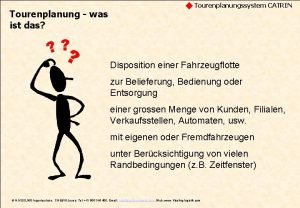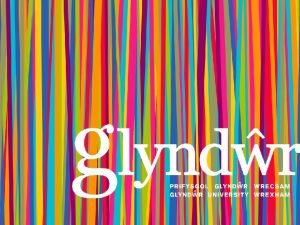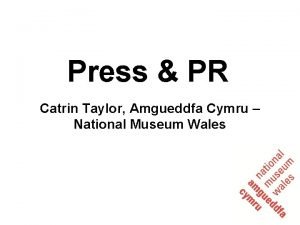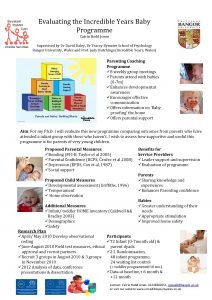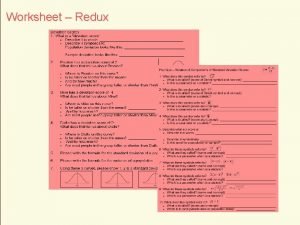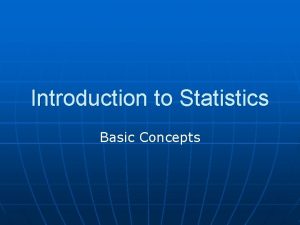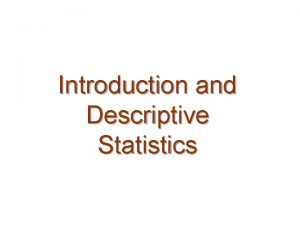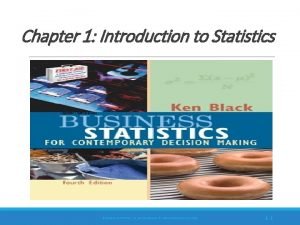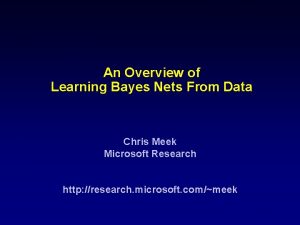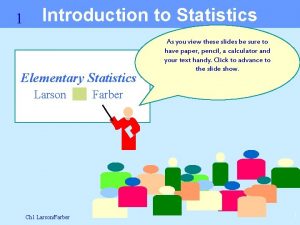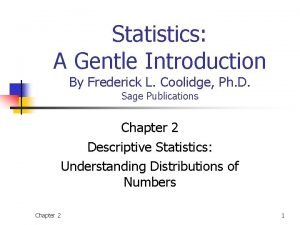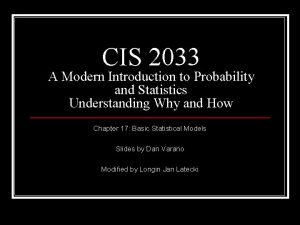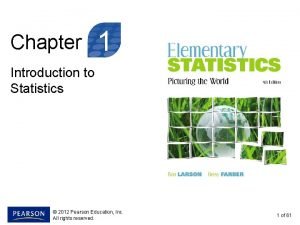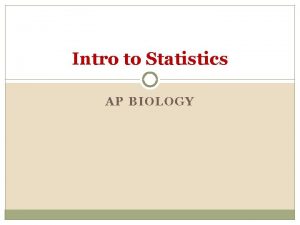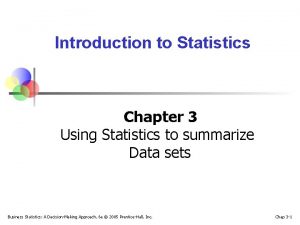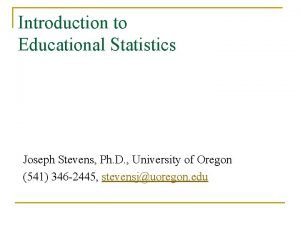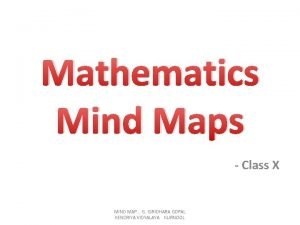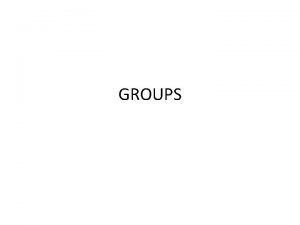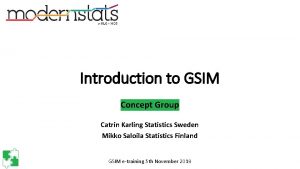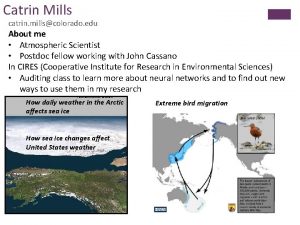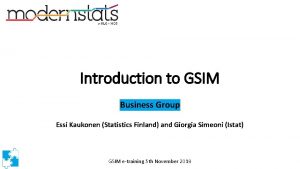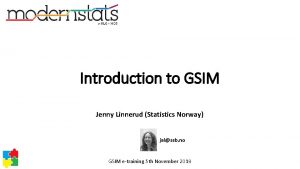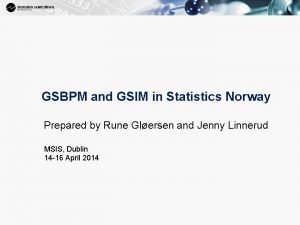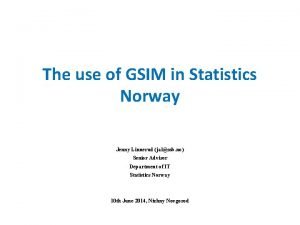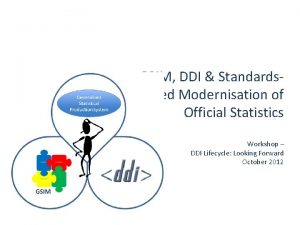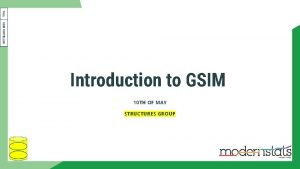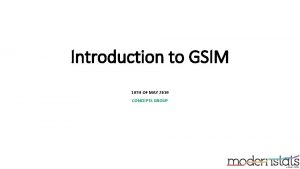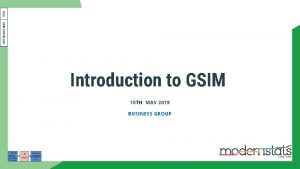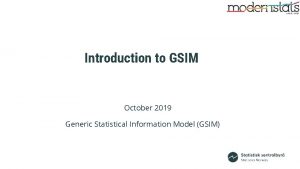Introduction to GSIM Concept Group Catrin Karling Statistics


































- Slides: 34

Introduction to GSIM Concept Group Catrin Karling Statistics Sweden Mikko Saloila Statistics Finland GSIM e-training 5 th November 2019

Concepts group The Concepts group is used to define the meaning of data, providing an understanding of what the data are measuring. In total 39 information objects

Agenda • Variable • Value Domain • Population • Statistical Classification

Information objects Variable measures Unit Type takes meaning from Represented Variable measures Value Domain

The Variable • The use of a Concept as a characteristic of a Population intended to be measured Variable measures Unit Type The Variable combines the meaning of a Concept with a Unit Type, to define the characteristic that is to be measured. Here are 3 examples: • Sex of person • Number of employees • Value of production

Unit Type A Unit Type is a class of objects of interest. Variable measures Unit Type A Unit Type is used to describe a class or group of Units based on a single characteristic, but with no specification of time and geography. For example, the Unit Type of “Person” groups together a set of Units based on the characteristic that they are ‘Persons’. It concerns not only Unit Types used in dissemination, but anywhere in the statistical process. E. g. using administrative data might involve the use of a fiscal unit.

Variable

Information objects Variable Total Income: The sum of income from work. . Unit Type measures Person takes meaning from Represented Variable measures Value Domain

Value Domain The set of permissible values for a Variable. The values can be described by enumeration or by an expression. Represented Variable measures Value Domain is a type of A Value Domain expressed as a list of Categories and associated Codes. Example - Sex Codes <m, male>; <f, female>; <o, other>. Enumerated Value Domain is a type of Described Value Domain A Value Domain defined by an expression. For example: All real decimal numbers between 0 and 1.

Represented Variable A combination of a characteristic of a population to be measured and how that measure will be represented Variable takes meaning from Represented Variable measures Value Domain Examples: The pair (Number of Employees, Integer), where "Number of Employees" is the characteristic of the population (Variable) and "Integer" is how that measure will be represented (Substantive Value Domain). If the Variable is "Industry" and the Substantive Value Domain is "Level 1 of NACE 2007", the pair is (Industry, NACE 2007 - Level 1). The Represented Variable "Sex of Person [1, 2, 3]", has the Variable (Sex of Person) and the representation (1=Male, 2=Female, 3=Other).

Represented Variable

Represented Variabel Variable Total Income: The sum of income from work. . Unit Type measures Person takes meaning from Total Income Represented Variable measures All Real Number Value Domain

Instance Variable Represented Variable takes meaning from Instance Variable measures Population contains Unit

Instance Variable The use of a Represented Variable within a Data Set. It may include information about the source of the data. The Instance Variable is used to describe actual instances of data that have been collected.

Instance Variable Here are 2 examples: 1) Gender: Dan Gillman has gender <m, male>, Arofan Gregory has gender<m, male>, etc. 2) Number of employees: Microsoft has 90, 000 employees; IBM has 433, 000 employees, etc. Unit Gender Dan Gillman m Arofan Gregory m Unit Number of Employees Microsoft 90, 000 IBM 433, 000

Population The total membership of a defined class of people, objects or events. A Population is used to describe the total membership of a group of people, objects or events based on characteristics, e. g. time and geographic boundaries. Here are 3 examples a) Adult persons in the US on 13 November 1956 b) Computer companies in the US at the end of 2012 c) Universities in the US 1 January 2011

Unit The object of interest in a Business Process. Here are 3 examples: a) Individual US person (i. e. , Arofan Gregory, Dan Gillman, Barack Obama, etc. ) b) Individual US computer companies (i. e. , Microsoft, Apple, IBM, etc. ) c) Individual US universities (i. e. , Johns Hopkins, University of Maryland, Yale, etc. )

Instance Variable Represented Variable Number of Employees takes meaning from Microsoft has 90, 000 employees Instance Variable measures Computer companies in the US at the end of 2012 Population contains Microsoft Unit

Variables Variable Number of Employees Unit Type measures is a type of Enterprises takes meaning from Represented Variable Number of Employees Value Domain measures Integer takes meaning from Microsoft has 90, 000 Employees Instance Variable measures Computer companies in the US at the end of 2012 Population contains Microsoft Unit

Coming up • Enumerated Value Domain • Statistical Classification • Level • Classification Item • Code • Category • Correspondence Table • Map

Enumerated Value Domain is a type of Enumerated Value Domain takes values from Code List takes values from Statistical Classification

Enumerated Value Domain A Value Domain expressed as a list of Categories and associated Codes. Explanatory text: Example - Sex Codes <m, male>; <f, female>; <o, other>.

Code List A list of Categories where each Category has a predefined Code assigned to it. Explanatory text: A kind of Node Set for which the Category contained in each Node has a Code assigned as a Designation. For example: 1 - Male 2 - Female Similar Code Lists can be grouped together (via the "relates to" relationship inherited from Node Set).

Statistical Classification A Statistical Classification is a set of Categories which may be assigned to one or more variables registered in statistical surveys or administrative files, and used in the production and dissemination of statistics. In a standard Statistical Classification, the Categories at each Level of the classification structure must be mutually exclusive and jointly exhaustive of all objects/units in the population of interest. Explanatory text: The Categories are defined with reference to one or more characteristics of a particular population of units of observation. A Statistical Classification may have a flat, linear structure or may be hierarchically structured, such that all Categories at lower Levels are sub. Categories of Categories at the next Level up. Categories in Statistical Classifications are represented in the information model as Classification Items.

Statistical Classification Series groups Statistical Classification has (via Node Set) compares (via Node Set) Level Code Category contains (via Node & Designation) contains groups (via Node) Classification Item takes meaning from (via Node) Correspondence Table maps (via Node) Map

Classification Series A Classification Series is an ensemble of one or more Statistical Classifications, based on the same concept, and related to each other as versions or updates. Typically, these Statistical Classifications have the same name (for example, ISIC or ISCO).

Level A Statistical Classification has a structure which is composed of one or several Levels. A Level often is associated with a Concept, which defines it. In a hierarchical classification the Classification Items of each Level but the highest are aggregated to the nearest higher Level. A linear classification has only one Level. Explanatory text: A Statistical Classification is a subtype of Node Set. The relationship between Statistical Classification and Level can also be extended to include the other Node Set types - Code List and Category Set.

Classification Item A Classification Item represents a Category at a certain Level within a Statistical Classification. It defines the content and the borders of the Category. A Unit can be classified to one and only one item at each Level of a Statistical Classification.

Correspondence Table A Correspondence Table expresses the relationship between two Statistical Classifications. These are typically: two versions from the same Classification Series; Statistical Classifications from different Classification Series; a variant and the version on which it is based; or, different versions of a variant. In the first and last examples, the Correspondence Table facilitates comparability over time. Correspondence relationships are shown in both directions. Explanatory text: A Statistical Classification is a subtype of Node Set. The relationship between Statistical Classification and Correspondence Table can also be extended to include the other Node Sets - Code List and Category Set.

Map A Map is an expression of the relation between a Classification Item in a source Statistical Classification and a corresponding Classification Item in the target Statistical Classification. The Map should specify whether the relationship between the two Classification Items is partial or complete. Depending on the relationship type of the Correspondence Table, there may be several Maps for a single source or target item. Explanatory text: The use of Correspondence Tables and Maps can be extended to include all types of Node and Node Set. This means that a Correspondence Table could map between the items of Statistical Classifications, Code Lists or Category Sets.

Examples Standard Industrial Classification 2008 and 2002 Classification Series groups Standard Industrial Classification 2008 Level 3 Statistical Classification has (via Node Set) compares (via Node Set) contains Level Code Category contains (via Node & Designation) groups (via Node) Classification Item takes meaning from (via Node) Correspondence Table 022 Logging maps (via Node) Map 020 Forestry, logging and related service activities corresponds to 022 Logging

Statistical Classification Level Code Classification Item Category

Correspondence Table Map Correspondance table between Standard Industrial Classification 2002 and 2008

More information about the Concept group? Concept group 39 information objects in GSIM v 1. 2
 Introduction to statistics what is statistics
Introduction to statistics what is statistics Disposition tourenplanung
Disposition tourenplanung Catrin finch centre wrexham
Catrin finch centre wrexham Catrin taylor
Catrin taylor Your dad did what analysis
Your dad did what analysis Catrin hedd jones
Catrin hedd jones Introduction to statistics worksheet
Introduction to statistics worksheet Introduction to statistics and some basic concepts
Introduction to statistics and some basic concepts Introduction to descriptive statistics
Introduction to descriptive statistics Chapter 1 introduction to statistics
Chapter 1 introduction to statistics Introduction to bayesian statistics
Introduction to bayesian statistics Introduction to elementary statistics
Introduction to elementary statistics Statistics a gentle introduction
Statistics a gentle introduction A modern introduction to probability and statistics
A modern introduction to probability and statistics Chapter 1 introduction to statistics
Chapter 1 introduction to statistics Introduction to statistics in ap biology
Introduction to statistics in ap biology Introduction to statistics chapter 3 answers
Introduction to statistics chapter 3 answers Introduction to educational statistics
Introduction to educational statistics Ideal self and true self
Ideal self and true self Pengertian pemasaran
Pengertian pemasaran Concept of child care
Concept of child care Pediatric nursing book rimple sharma pdf free download
Pediatric nursing book rimple sharma pdf free download Trigonometry concept map
Trigonometry concept map Social psychology examples
Social psychology examples Y = a(b)^x
Y = a(b)^x Anova within group and between group
Anova within group and between group Primary group
Primary group Joint royal college of physicians training board
Joint royal college of physicians training board Lattice energy trend
Lattice energy trend Amino group and carboxyl group
Amino group and carboxyl group Amino group and carboxyl group
Amino group and carboxyl group In group out group
In group out group Group yourself or group yourselves
Group yourself or group yourselves William graham sumner in group out group
William graham sumner in group out group Joining together group theory and group skills
Joining together group theory and group skills

